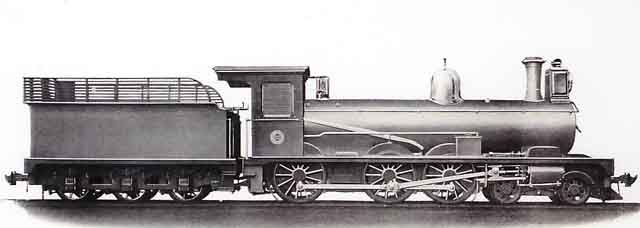
Class G
A
series of 34 4-6-0 locomotives built by Kitson (16), Hunslet (9),
Neilson Reid (6) & R. Stephenson (3).
These became FMSR Class G and were
ordered initially by Perak and Selangor with four each in 1898.
More small orders followed for these two railways and for the
FMSR from 1903, with two going to the Malacca Railway in 1904.

Above: Hunslet Class G as Perak 22.
Below: Kitson Class G as FMSR 59.
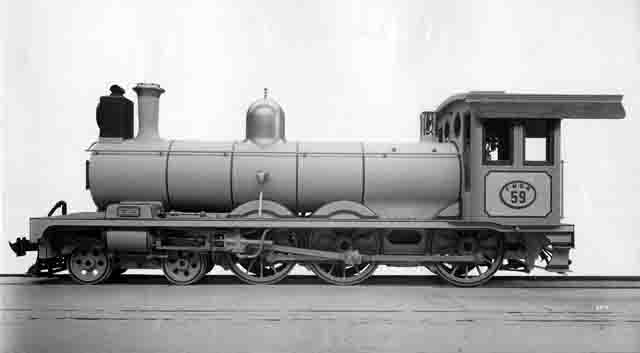
Below: in order, FMSR 41, FMSR 62 & FMSR 57. All 3 photographs reproduced with permission from the Stephenson Locomotive Society, they are thought to be from the H M le Fleming collection.
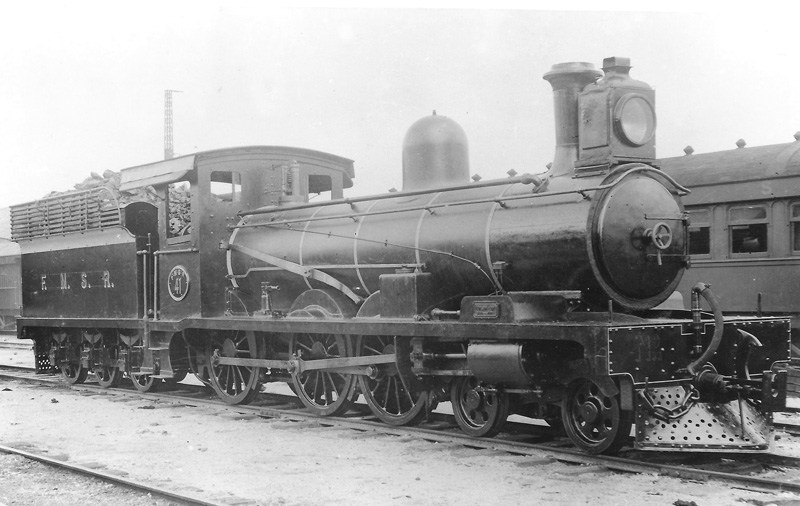
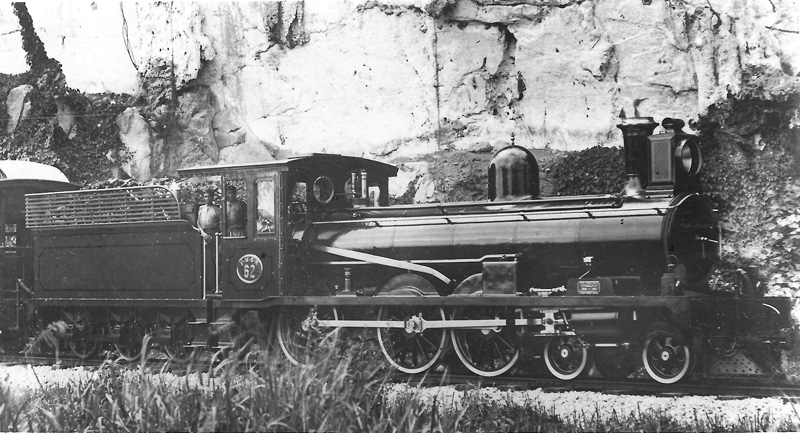
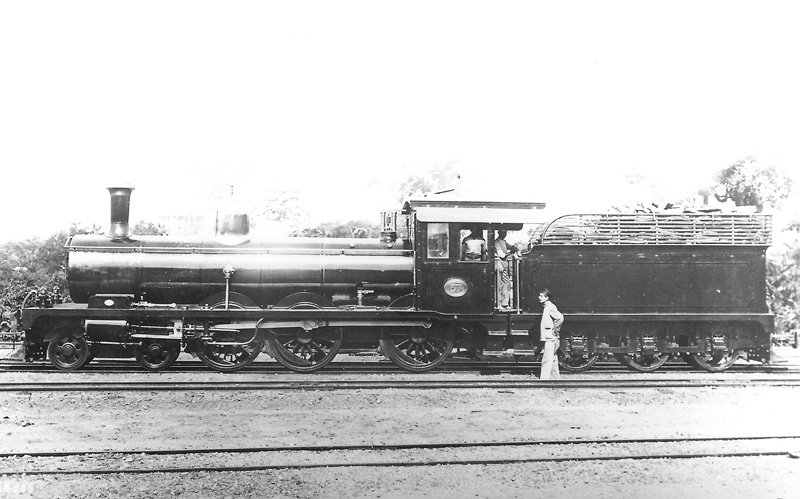
| Maker | Number | Year | First Owner/number | FMSR No. | Date to FMSR | Notes | |
|
|
1899 |
Perak Railway |
21 |
36 |
July 1901. |
Scrapped 1/1931 |
|
|
1899 |
Perak Railway |
22 |
37 |
July 1901. |
Scrapped 2/1932 |
|
|
1899 |
Perak Railway |
23 |
38 |
July 1901. |
Scrapped 11/1930 |
|
|
1899 |
Perak Railway |
24 |
39 |
July 1901. |
Scrapped 8/1929 |
Kitson |
3863 |
1898 |
Selangor Railway |
11 |
40 |
July 1901. |
Scrapped 2/1928 |
Kitson |
3864 |
1898 |
Selangor Railway |
12 |
41 |
July 1901. |
|
Kitson |
3865 |
1898 |
Selangor Railway |
13 |
42 |
July 1901. |
|
Kitson |
3866 |
1898 |
Selangor Railway |
14 |
43 |
July 1901. |
|
Kitson |
3984 |
1901 |
Selangor Railway |
15 |
44 |
July 1901. |
Scrapped 11/1931 |
Kitson |
3985 |
1901 |
Selangor Railway |
16 |
45 |
July 1901. |
|
R Stephenson |
|
1901 |
Perak Railway |
25 |
46 |
July 1901. |
|
R Stephenson |
|
1901 |
Perak Railway |
26 |
47 |
July 1901. |
|
R Stephenson |
|
|
Perak Railway |
27 |
48 |
July 1901. |
|
Kitson |
4110 |
1902 |
Selangor Railway |
17 |
49 |
July 1901. |
Still active 4/1938 |
Kitson |
4111 |
1902 |
Selangor Railway |
18 |
50 |
July 1901. |
Still active 4/1938 |
|
6105 |
1902 |
Perak Railway |
28 |
51 |
July 1901. |
Scrapped 7/1934 |
|
|
1902 |
Perak Railway |
29 |
52 |
July 1901. |
|
|
|
1902 |
Perak Railway |
30 |
53 |
July 1901. |
Still active 4/1938 |
|
|
1902 |
Perak Railway |
31 |
54 |
July 1901. |
Still active 4/1938 |
|
|
1902 |
Perak Railway |
32 |
55 |
July 1901. |
Scrapped 4/1934 |
|
|
|
Perak Railway |
33 |
56 |
July 1901. |
Still active 4/1938 SSB |
Kitson |
4189 |
1903 |
|
|
57 |
|
Withdrawn 5/1934 |
Kitson |
4190 |
1903 |
|
|
58 |
|
Withdrawn 7/1947 |
Kitson |
4238 |
1903 |
|
|
59 |
|
Withdrawn 2/1934 & 7/1947 |
Kitson |
4239 |
1903 |
|
|
60 |
|
Withdrawn 5/1934 |
Kitson |
4279 |
1904 |
|
|
61 |
|
Withdrawn 1/1931 |
Kitson |
4280 |
1904 |
|
|
62 |
|
Withdrawn 2/1930 |
Kitson |
4289 |
1904 |
Malacca Railway |
3 |
68 |
1905 |
Scrapped 8/1931 |
Kitson |
4290 |
1904 |
Malacca Railway |
4 |
69 |
1905 |
|
Hunslet |
860 |
1905 |
|
|
63 |
|
Withdrawn 11/1930 |
Hunslet |
861 |
1905 |
|
|
64 |
|
Withdrawn 4/1934 |
Hunslet |
862 |
1905 |
|
|
65 |
|
Withdrawn 2/1928 |
Hunslet |
863 |
1905 |
|
|
66 |
|
Withdrawn 2/1934 |
Hunslet |
864 |
1905 |
|
|
67 |
|
Renumbered 57* 1938 |
* Indicates a number previously carried by another
locomotive
#1 An alteration of le Fleming's 1936 list states "SSB ret'd 1946 to be struck off" but Ramaer does not record it in Siam. SSB indicates that locomotive was transferred to Siam and South Burma by the Japanese.
#2 le Fleming wrote "s. 2/34" in his 1936 list but an alteration dittoes "to be struck off"
Regarding the discrepancies noted above I have come across the following statements:
“The engines are the last two G
class 4-6-0 steam locomotives we have left running, they first have a flatbed,
with cow catcher on front, weighted down with bagged rock ballast, second comes
a cut down open wagon, with a Vickers machine gun, then another taller open
wagon, with a 6 pounder 6 cwt Hotchkiss Mk I gun inside, then another open wagon
with a single Vickers 2 pounder Mk II Pom-Pom AA gun and then the locomotive and
tender, two coaches, followed by an open wagon with a second Vickers 2 pounder
Mk II Pom-Pom AA gun, and lastly another cut down open wagon, with a Vickers
machine gun. All are protected by armour plate on the sides, and to some degree,
above. The armour plate used will stop rifle and machine gun fire, shell
splinters and grenades. They have a train and gun crew complement of 31, not
counting any troops or engineers they might carry.”
Historically, there was an armoured train used by the British in Malaya in 1941,
although there's precious little detail about it.
Percival's Operations of Malaya Command, The Opening of Hostilities, 131, says
"Concurrently, an armoured train, with a detachment of 2/16 Punjab Regt, and
some engineers, advanced into Thailand from Padang Besar in Perlis." And later
in the paragraph we have "Meanwhile the armoured train party had reached Klong
Gnea, in Thailand and successfully destroyed a large bridge before withdrawing
to Padang Besar."
Then moving to West Coast Operations 12th-17th December, 1941, 191, says "During
the day (16th December) the units of the 11th Division were being reformed in
Province Wellesly, covered by a weak rear-guard which consisted of one platoon
and the armoured train on the railway bridge (over the River Muda) "
Alam Warren, in his book, Singapore 1942, Britain's Greatest Defeat, mentions
the train's advance into Thailand subsequent withdrawal. Later, page 100, after
detailing Murray-Lyon's brush with an advance party of Japanese cyclists at the
Alor Star road bridge over the Kedah River, he goes on to say
"Soon after the road bridge was blown the demolitions on the rail bridge to the
east were also set off. The charges failed to do their task and the bridge was
left sagging, the rails broken, but still standing. An armoured train had been
cut off north of the river by the attempt to demolish the bridge. Somebody
decided to drive the train over the bridge in a final 'Hollywood' style bid to
collapse the damaged structure. The train was slowly rolled towards the bridge.
The crew leapt off, but, with its whistle jammed and shriking loudly, the train
jumped the broken rails and steamed off southwards".
What happened to the train afterwards I'm not sure, and I have no idea if there
was just the one armoured train of two, what steam engines were used, and what
armour and guns they were equipped with?
It would appear that the locomotives were probably G class numbers 56 & 58, though 59 is also a possibility.
| NOTES: | 1. | 59 was named LADY WELD, 60 was named LADY TREACHER. |
| 2. | Although the FMSR was officially formed on 1st July 1901 the Perak and Selangor Railways were not physically connected until 15th August 1903 so the renumbering probably took place around that date. Kitson 4189 and 4190 were completed in February 1903 so would have been delivered around the middle of 1903, being the first locomotives to carry FMSR numbers from new. |
| A & B classes | |||
| Burma E and O | C² class | ||
| H class | |||
| L class | |||
| M class | O class | P class | Mallet |
| Q class | |||
| WWII | Sentinel | WD class |
Page created 25th December 2004.
Updated 18th October 2023.
This page has been visited times